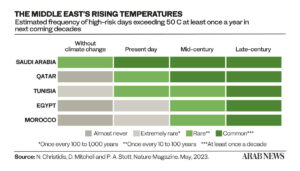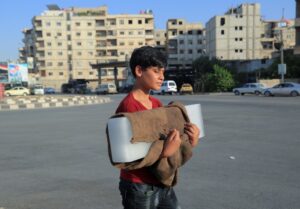
- ARAB NEWS
- 04 Jul 2025

DUBAI: Nations worldwide are once again in the throes of coping with record-high temperatures amid an intense summer heatwave, forcing governments in the Middle East, Europe and the Americas to issue health warnings and advise people to remain indoors and stay hydrated.
Several recent studies, including a report by the World Meteorological Organization, have warned that there is a 66 percent chance of exceeding the global temperature threshold of 1.5 C above pre-industrial levels in at least one year between 2023 and 2027.
“This is a significant marker as it represents the upper limit set by the Paris Agreement to prevent catastrophic changes to our planet’s ecosystems,” Zoltan Rendes, chief marketing officer of SunMoney Solar Group and an ambassador for the EU’s European Climate Pact, told Arab News.
Scientists warn that the planet might already have crossed a critical threshold in climate change, including reports of record-high ocean temperatures, thereby pushing the world into “uncharted territory” with severe implications for marine life and global weather patterns over the next decade.

“These developments underscore the urgency of addressing climate change and highlight the critical role of science and technology in finding solutions,” said Rendes.
The report states that while a breach of the 1.5 C threshold in the next five years might only be temporary, there is a 98 percent chance that at least one of the next five years, and the five-year period as a whole, will be the warmest on record for the planet.
This summer alone, deadly heatwaves in Europe have forced Italian authorities to place 16 cities on red alert. Meanwhile, ground temperatures in Spain have surpassed 60 C, threatening an even hotter summer season than last year.
Temperatures of more than 50 C in the US mean that a third of Americans are living under health advisories, and temperature records are expected to be broken in as many as 38 cities across the country in the coming months.
Scorching temperatures have also been reported in Asia and the Middle East. China, for example, recorded its hottest temperature yet as the mercury rose above 52 C in Xinjiang, breaking the previous record of 50.3 C. In the UAE, Abu Dhabi emirate recorded a temperature of 50.1 C in its western Al-Dhafra region for two consecutive days.
Other Gulf Cooperation Council member nations, including Oman and Kuwait, have similarly recorded temperatures ranging from the mid-to-high 40s this month, and are likely to hit the 50 C mark at some point during summer.
The all-too evident changes in global weather patterns, especially during summer months, are just another sign that the world is way off track in its efforts to reduce greenhouse-gas emissions by the required 45 percent by 2030, and the goal of reaching net zero by 2050.
Where does that leave countries with climates that were already hotter than most? And what would happen to the world if the 1.5 C threshold breach is not temporary?

These questions will be addressed during the UN Climate Change Conference, COP28, and the first Global Stocktake of the Paris Agreement, which will take place in Dubai beginning on Nov. 30. More than 80,000 delegates and 140 heads of state and government are expected to attend.
The conference aims to accelerate the transition to a low-carbon, high-growth, sustainable economic model through specific actions that focus on four paradigm shifts, said Philipp Rosenthal, associate director of the climate change, carbon and waste team at the WSP consultancy. These include fast-tracking the energy transition, transforming climate finance, prioritizing nature and people in climate action, and mobilizing for an inclusive summit.
“The goal is to create vast economic potential while addressing the urgent need for emissions reduction and fulfilling commitments under the Paris Agreement,” Rosenthal told Arab News.
Additionally, the outcome of the Global Stocktake, described as “a critical turning point for climate action,” will provide an opportunity to align global efforts and put the world on track to a more sustainable future.
“More and more countries, regions, cities and companies have established carbon-neutrality targets, and zero-carbon solutions are becoming competitive across economic sectors representing 25 percent of emissions,” said Rosenthal.
This trend is most noticeable in the power and transportation sectors and has created many new business opportunities for early movers, he said, adding that by 2030, zero-carbon solutions could be competitive in sectors representing more than 70 percent of global emissions.
Countries around the world have also viewed the global focus on sustainability as an opportunity to diversify their economies and adopt new technologies and expertise. The Gulf countries, most notably the UAE and Saudi Arabia, are two strong examples of this.

“The UAE has successfully diversified its economy. In 1971, the oil sector contributed 90 percent to the country’s GDP and today this number has significantly decreased to 28 percent,” Rory McCarthy, chief operating officer and partner at Yellow Door Energy, told Arab News.
He said that in addition to the UAE’s ambitious 2050 Energy Strategy, the country has heavily invested in solar power and is now home to several of the world’s largest solar parks, including the Mohammed bin Rashid Al-Maktoum Solar Energy Park in Dubai and the Al-Dhafra and Noor solar plants in Abu Dhabi.
“Saudi Arabia has the Saudi Green Initiative, part of Vision 2030, where among the targets are to reduce carbon emissions by 278 million tons per annum by 2030, reach 50 percent clean-energy generation by 2030 and plant 10 billion trees (as well as 40 billion trees across the Middle East),” said McCarthy.
Moreover, through the execution of its Vision 2030 initiative, the Kingdom aims to reduce its dependence on oil, diversify its economy, and develop public service sectors such as health, education, infrastructure, recreation and tourism.
Overall, Gulf countries are investing heavily in renewable-energy projects, all focused on sustainability and, more specifically, the production and use of green hydrogen.
“These initiatives represent a significant shift in the region’s energy policies,” said Rendes.
“While these countries have historically been associated with high levels of hydrocarbon production, their efforts to transition toward renewable energy sources demonstrate a growing awareness of the need to address climate change.”
Nevertheless, the scale of the challenge is enormous, said Rendes, and the success of these efforts will depend on a range of factors, including technological advancements, economic considerations and political will. After all, the stakes are high and the consequences of global warming can be detrimental on the world as a whole.
“If the 1.5 C climate threshold is exceeded, sea levels will continue to rise, leading to increased coastal flooding and erosion,” said Rosenthal.
“Extreme weather events, like hurricanes, droughts and heatwaves, will become more frequent and severe, impacting agriculture, water resources and human health.”

Entire ecosystems could face significant disruptions, leading to the loss, and potential collapse, of biodiversity. Additionally, there could be a higher risk of irreversible tipping points, such as the melting of major ice sheets and the release of large amounts of greenhouse gases from thawing permafrost.
“The impacts will be profound and have far-reaching consequences for both human societies and the natural world,” said Rosenthal.
The UN has issued a fresh warning about the increasing likelihood of the El Nino weather phenomenon occurring in the coming months, resulting in higher global temperatures and new heat records, as 2023 witnesses the end of an unusual run of three successive La Nina years.
El Nino and La Nina, which result from variations in wind strength and ocean temperatures in the Pacific Ocean, bring with them distinctive climate patterns. While El Nino events release heat from the ocean and add up to 0.2 C to global surface temperatures, La Nina events contribute to increased heat absorption by the ocean, said Rosenthal.
As a result, the El Nino-La Nina cycle has significant effects on various regions, especially in the tropics, causing heatwaves, droughts, floods and wildfires.
“The impact of climate change and El Nino events on the Middle East, particularly Gulf countries like Saudi Arabia, the UAE and Qatar, is a topic of intensive study,” said Rendes.
While El Nino is a natural climate phenomenon that occurs irregularly every two to seven years and contributes to global temperature increases, there is ongoing research taking place in an attempt to understand whether climate change might influence its frequency or intensity.

Similarly, in a region already known for extreme heat and aridity, further research is also needed to fully understand the specific effects of El Nino.
What is certain is that weather conditions are expected to worsen due to global warming, causing potentially irreversible effects such as food insecurity, disruption to agriculture, water shortages and human health risks, said Rendes.
“While these impacts paint a grim picture, it’s important to note that efforts to mitigate climate change and adapt to its effects can help reduce these risks,” he said.
“However, time is of the essence, and decisive action is needed now more than ever.”